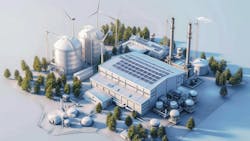Decarbonization as a Business Priority Is Here to Stay
For a successful energy transition, manufacturers must be pragmatic while overcoming inherent sector challenges. The federal government reports that manufacturing accounts for 12% of U.S. greenhouse gas pollution, with 75% of those emissions attributed to heat generated for industrial processes or transportation.
Consequently, manufacturing companies now face mounting pressure from stakeholders globally to effectively reduce their greenhouse gas emissions. Leaning into sustainability can reduce risk, build trust and improve performance. A Harvard Business School study found that companies that perform highly on material sustainability factors experience an 8.9% increase in annualized share price, compared with companies that underperform in sustainability topics.
Regardless of the potential impact of sustainability performance, over 92% of global GDP is covered by some form of net-zero target. Decarbonization as a priority is here to stay.
However, the manufacturing sector’s relatively high operating leverage and trade-sensitive nature make it difficult to decarbonize as quickly as other sectors. Rushing to adopt emerging technologies just because they are becoming more popular or have government subsidies attached to them may have unintended consequences and risks.
A more pragmatic approach that incorporates impact, timing, feasibility and cost is crucial for manufacturing leaders to effectively manage decarbonization and the energy transition. Balancing decarbonization, operating metrics and financial analysis is central to this approach. Maturing low-carbon technologies such as wind and solar plus energy storage used to be less pervasive and more expensive than incumbent technologies, but they are now seeing dramatic gains in deployment and cost competitiveness. In just the past decade, the costs of solar energy and energy storage have fallen 87% and 85%, respectively. As more emerging low-carbon technologies work their way down the cost curve, it makes sense to align the retirement date of fossil energy assets with the maturation and economic compatibility of lower-carbon alternatives. This alignment provides manufacturers vital breathing room to pilot emerging technologies and evaluate their potential prior to making wholesale changes.
Here are four questions that should guide the development of practical, effective manufacturing decarbonization strategies.
1. What is the current environmental impact? Manufacturers should start with a complete and accurate greenhouse gas inventory that includes Scope Three categories relevant to your business. While fuel combustion for heat generation produces significant emissions, the second-largest category is manufacturing process emissions.
For example, the cement-making process heats limestone to obtain calcium oxide. Though it does not involve fossil fuel combustion, the process typically results in the release of carbon dioxide. Both upstream and downstream distribution of products, as well as the embodied carbon in raw material inputs, usually drive manufacturing emissions. A roadmap for decarbonization must identify “hot spots”—the areas producing the most emissions.
While smaller sources of emissions may not have as much impact, addressing them can be critical to the longer-term success of a company’s sustainability journey. Highly visible but sometimes lower-impact initiatives such as office recycling, environmental volunteerism for employees or electric vehicle charging infrastructure for employee and customer utilization can both galvanize support and send a strong signal about the company’s strategy and priorities to employees and customers.
2. How can timing help? By reviewing fixed-asset replacement schedules, manufacturing leaders can identify opportunities when near-term asset retirements align with transitions to cleaner technologies. While a long-lived natural gas furnace recently placed into service is unlikely to be replaced, the furnace scheduled for replacement next year might be an ideal test case.
Decarbonization is an incremental process, so being mindful of asset lives can help narrow down and prioritize steps toward decarbonization. Once asset-replacement schedules have been reviewed, the interim time can be used for piloting emerging low-carbon technologies. By deliberately testing new technologies, manufacturers can accelerate the learning curve and better understand interdependencies. Pilots can provide templates for what a best-in-class manufacturing plant might look like down the road.
3. What are the options and their feasibility? Organizations should prioritize understanding the problem they are trying to solve rather than falling in love with a specific solution. It’s helpful to start with a long list of technologies and options to address the problem. Cross-functional teams can then evaluate the feasibility of each option. For example, lower-carbon biomass feedstocks may produce as much heat as natural gas combustion, yet the biomass feedstock available near your facility may not suit your operational needs. By assessing feasibility, organizations can narrow down the long list of options to a short list that includes the incumbent technology.
4. Where are the costs? Building a total cost of ownership model to evaluate competing product alternatives may seem straightforward, but incorporating the risks and opportunities that could materially influence financial decisions requires additional work. For instance, as more countries regulate the social impact of greenhouse-gas pollution, carbon pricing regulations and taxes are becoming more common. Including a proxy price for emissions in the evaluation can account for the potential future impact of these taxes, even in jurisdictions where they may not yet be present. There are also other potential future costs associated with maintaining fossil fuel assets. For example, commercial customers flocking to lower-carbon alternatives can drive up the cost of incumbent fossil technology, creating a spiral that can quickly turn existing fossil fuel infrastructure into a stranded asset.
It’s also essential to evaluate the potential benefits of lower-carbon alternatives. Statutory state and federal clean-energy tax credits and incentives, as well as competitive grants from agencies such as the U.S. Department of Energy (DOE), can quickly tip a financial calculation in favor of the low-carbon alternative. Consumer products giant Kraft Heinz recently announced a $170 million award from the DOE’s Office of Clean Energy Demonstrations to support the implementation of clean-energy projects at 10 of the company’s U.S. plants.
In addition to subsidies, there are other benefits for manufacturers vertically integrating new energy solutions. For instance, using a power purchase agreement to generate electricity with wind or solar plus storage can reduce reliance on third parties as well as de-risk energy price volatility. A holistic approach to building a total cost of ownership model for incumbent and low-carbon alternatives can help ensure sound capital-spending decisions that set the company up for long-term success. Ultimately, decarbonization initiatives that don’t make financial sense are inherently unsustainable and counterproductive to successfully managing the energy transition.
In the drive toward decarbonization, manufacturers should ask themselves crucial questions about these four areas to navigate the energy transition’s risks and opportunities effectively. Adopting a practical and holistic approach can lead to decisions that align both business and environmental goals, ensuring a successful journey toward a low-carbon future.
About the Author

Todd Dubner
Industrial Manufacturing Strategy Leader, KPMG
Todd Dubner has more than 25 years of experience in strategy and corporate development. Currently, Todd primarily serves the Automotive and Logistics industries, consulting to passenger and commercial vehicle OEMs, Tier 1 suppliers and fleet operators.
Josh Hesterman
Industrial Manufacturing Sustainability Leader, KPMG
Josh is a managing director in KPMG’s sustainability Climate Advisory practice with over 15 years of broad-based, strategic consulting experience. Josh works with both public and private clients across numerous sectors to design practical strategies balancing environmental, financial, and operational considerations.
